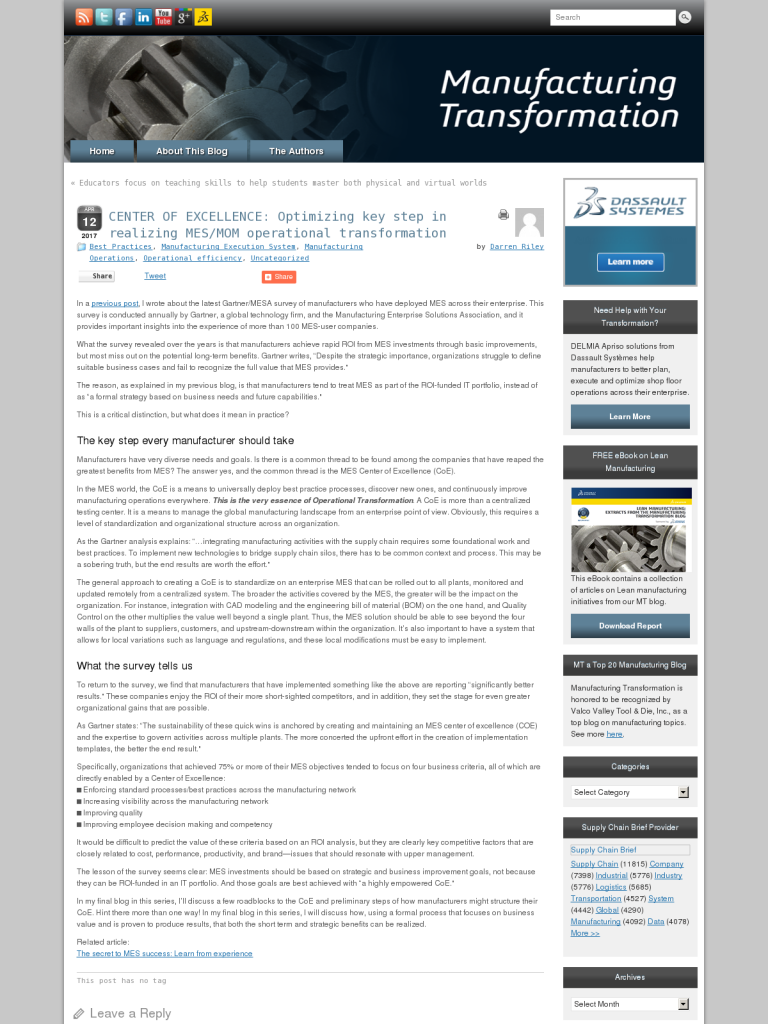CENTER OF EXCELLENCE: Optimizing key step in realizing MES/MOM operational transformation
Blog: Apriso Blog
In a previous post, I wrote about the latest Gartner/MESA survey of manufacturers who have deployed MES across their enterprise. This survey is conducted annually by Gartner, a global technology firm, and the Manufacturing Enterprise Solutions Association, and it provides important insights into the experience of more than 100 MES-user companies.
What the survey revealed over the years is that manufacturers achieve rapid ROI from MES investments through basic improvements, but most miss out on the potential long-term benefits. Gartner writes, “Despite the strategic importance, organizations struggle to define suitable business cases and fail to recognize the full value that MES provides.”
The reason, as explained in my previous blog, is that manufacturers tend to treat MES as part of the ROI-funded IT portfolio, instead of as “a formal strategy based on business needs and future capabilities.”
This is a critical distinction, but what does it mean in practice?
The key step every manufacturer should take
Manufacturers have very diverse needs and goals. Is there is a common thread to be found among the companies that have reaped the greatest benefits from MES? The answer yes, and the common thread is the MES Center of Excellence (CoE).
In the MES world, the CoE is a means to universally deploy best practice processes, discover new ones, and continuously improve manufacturing operations everywhere. This is the very essence of Operational Transformation. A CoE is more than a centralized testing center. It is a means to manage the global manufacturing landscape from an enterprise point of view. Obviously, this requires a level of standardization and organizational structure across an organization.
As the Gartner analysis explains: “…integrating manufacturing activities with the supply chain requires some foundational work and best practices. To implement new technologies to bridge supply chain silos, there has to be common context and process. This may be a sobering truth, but the end results are worth the effort.”
The general approach to creating a CoE is to standardize on an enterprise MES that can be rolled out to all plants, monitored and updated remotely from a centralized system. The broader the activities covered by the MES, the greater will be the impact on the organization. For instance, integration with CAD modeling and the engineering bill of material (BOM) on the one hand, and Quality Control on the other multiplies the value well beyond a single plant. Thus, the MES solution should be able to see beyond the four walls of the plant to suppliers, customers, and upstream-downstream within the organization. It’s also important to have a system that allows for local variations such as language and regulations, and these local modifications must be easy to implement.
What the survey tells us
To return to the survey, we find that manufacturers that have implemented something like the above are reporting “significantly better results.” These companies enjoy the ROI of their more short-sighted competitors, and in addition, they set the stage for even greater organizational gains that are possible.
As Gartner states: “The sustainability of these quick wins is anchored by creating and maintaining an MES center of excellence (COE) and the expertise to govern activities across multiple plants. The more concerted the upfront effort in the creation of implementation templates, the better the end result.”
Specifically, organizations that achieved 75% or more of their MES objectives tended to focus on four business criteria, all of which are directly enabled by a Center of Excellence:
■ Enforcing standard processes/best practices across the manufacturing network
■ Increasing visibility across the manufacturing network
■ Improving quality
■ Improving employee decision making and competency
It would be difficult to predict the value of these criteria based on an ROI analysis, but they are clearly key competitive factors that are closely related to cost, performance, productivity, and brand—issues that should resonate with upper management.
The lesson of the survey seems clear: MES investments should be based on strategic and business improvement goals, not because they can be ROI-funded in an IT portfolio. And those goals are best achieved with “a highly empowered CoE.”
In my final blog in this series, I’ll discuss a few roadblocks to the CoE and preliminary steps of how manufacturers might structure their CoE. Hint there more than one way! In my final blog in this series, I will discuss how, using a formal process that focuses on business value and is proven to produce results, that both the short term and strategic benefits can be realized.
Related article:
The secret to MES success: Learn from experience
Leave a Comment
You must be logged in to post a comment.








